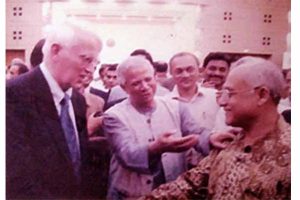
bdmetronews desk ॥ Discovery’s Shark Week continues tonight with the premiere of three new specials: At 8 p.m., it’s Shallow Water Invasion, which looks at great whites moving into shallow at night at Mexico’s Guadalupe Island. At 9 p.m., it’s Jaws of the Deep, which finds marine biologist Greg Skomal and the REMUS SharkCam team deploying a new AUV (autonomous underwater vehicle) at Guadalupe Island to capture footage of great whites “gliding” — and possibly “napping.” And at 10 p.m., Dr. Craig O’Connell returns to do more testing on his Sharksafe Barrier in Sharks Among Us.
The sneak peek above from Jaws of the Deep reveals a Shark Week first: a great white stops moving its tale while it descends. “Scientists have been theorizing that sharks in general will glide when they dive deep, but no one has ever seen it before,” Skomak tells Yahoo TV. “We had indirect observations from accelerometers that scientists have put on sharks, which kind of give you a sense of how the animals are moving. The beauty of SharkCam is that it provides direct observations. Here, we had confirmation that what we suspected was true. That’s pretty exciting!”
Another first: SharkCam 2 also trails a shark as it appears to rest. “Of course, we can’t confirm what it’s really doing. We can’t get into the head of the white shark. But people have hypothesized about whether sharks sleep,” Skomal says. “Many shark species have to swim in order to breath. Here, we have first observations of what might actually be resting behavior — a shark orienting into the current, opening its mouth so that more water goes into its mouth, over its gills, and it can just idle along and shut probably part of its body down, parts of its brain down, and really rest. You’ve got an animal that expends a tremendous amount of energy throughout the day hunting. At some point, it’s got to get tired.”
Of course, there is one familiar shot in the special: the SharkCam engineers getting nervous when their expensive instruments get attacked or, worse, stuck under a ledge. “I have to admit when things start to go awry, to see their passion erupt in anxiety… it’s great, because it indicates their commitment to what their doing, their excitement. I also find it somewhat humorous, which is the twisted side of me, of course,” Skomal says, laughing. “Marine engineers are fantastic people. They’ve provided this technology to us to study these animals. It does produce amazing, high quality, incredible footage that entertains the masses. My goal, ultimately, is also to educate [people] as well, and to bring them in the fold and inspire within them the respect for these animals that I have, so that ultimately, they want to protect them as much as I do.”
Protection — for both sharks and humans — is also the mission for Dr. Craig O’Connell. Shark Week fans will remember him from last year’s Shark Island special, which investigated why bull sharks are drawn to Reunion Island in the Indian Ocean and whether O’Connell’s Sharksafe Barrier could ever be an option to nets that often drown sharks and other marine wildlife.
His Sharksafe Barrier looks like a dense (artificial) kelp forest, which sharks tend to avoid, and uses magnets, which repel them.
While testing the barrier on bull sharks in the Bahamas, O’Connell found inspiration in two shark attack survivors: Hunter Treschl, a teen who lost an arm to a bull shark last summer in North Carolina, and Paul de Gelder, an ex-special forces diver who lost part of an arm and a leg to a bull shark during a counterterrorism exercise in Sydney Harbor in 2009. Paul is a Shark Week vet, but this was Hunter’s first time back in the ocean since his attack. “I told Hunter, ‘Hunter, you don’t have to go in if you don’t want to. It’s okay. You can watch from the surface, or you don’t even have to watch. Just you being here means a lot,’” O’Connell says. “He was like, ‘No, I want to go in.’ He was ready to do it. I can remember a moment where I was in the cage talking to them over the com, and I said, ‘Guys, I don’t even care if my experiment works right now, this is one of the best dives of my life, just because you’re in here with me.’ It meant a lot, because they are both facing their fears to help me with my work. It was a really special moment, and it was, by far, one of my most favorite dives in my life.“
by yahoo






